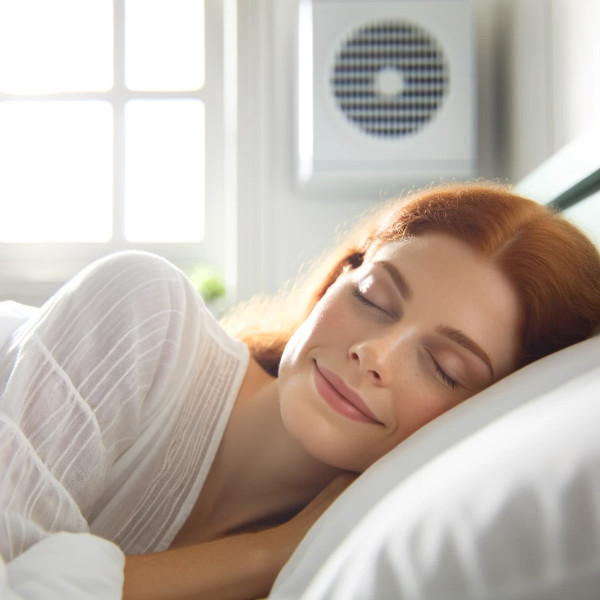Fastlec uses cookies to ensure that we give you the best experience on our website. If you continue we assume that you consent to receive all cookies on the Fastlec website. Read More.
Blog
All of the latest news and insights into the electrical world, from Fastlec.
From Stuffy Nights to Sweet Dreams, One Breath at a Time
Imagine this: you crawl into bed, exhausted after a long day. You snuggle under the covers, anticipation simmering for a night of blissful slumber. Yet, despite your best efforts, sleep remains elusive. Hours tick by, punctuated by restless tossing and turning. Frustration creeps in, as does the familiar fog of sleep deprivation.
This scenario, unfortunately, is far from uncommon. Millions around the world struggle with sleep issues, their bedrooms harbouring an unexpected culprit: poor ventilation.
While we often focus on factors like stress, screen time, or caffeine, the air we breathe within our sanctuaries of slumber plays a critical, and often overlooked, role in sleep quality. Today, let's delve into the fascinating "Sleep Connection," exploring how proper ventilation can unlock the door to deeper, more restorative rest.
The CO2 Conundrum:
Remember that satisfying sigh of relief after finally getting out of a stuffy room? It's not just your imagination. As we sleep, our bodies exhale carbon dioxide (CO2). In a poorly ventilated bedroom, this CO2 can accumulate, creating a silent enemy that disrupts our sleep cycles. Studies by the National Institutes of Health (NIH) and Harvard University show that even slightly elevated CO2 levels (as low as 1000 ppm) can significantly impact cognitive function and sleep quality leading to:
- Headaches
- Fatigue
- Difficulty breathing
- Restlessness
- Reduced sleep quality
Imagine trying to drift off while trapped in a stuffy, stagnant bubble of your own exhaled air. Not exactly the recipe for restful slumber, is it?
The Allergy Assault:
For many, sleep is marred by the constant sniffles and coughs of allergies. Dust mites, pet dander, and volatile organic compounds (VOCs) from furniture and cleaning products can all lurk in poorly ventilated bedrooms, triggering allergy and asthma symptoms. Proper ventilation helps filter out these airborne nasties, creating a sleep haven for even the sniffiest sleepers.
Humidity Hijinks:
On the flip side, excessive humidity can transform your bedroom into a tropical sauna, making it feel stuffy and uncomfortable. This can lead to difficulty falling asleep and staying asleep. Ventilation helps remove excess moisture, creating a more breathable, and therefore restful, environment.
Temperature Tango:
Beyond CO2, proper ventilation plays a crucial role in regulating bedroom temperature. Ever tossed and turned on a sweltering night? You're not alone. Overheating can disrupt sleep cycles and lead to frequent waking. Adequate ventilation allows heat to escape, creating a cooler environment for deeper sleep.
The Stats Speak Volumes:
The connection between ventilation and sleep isn't just anecdotal; it's backed by compelling data.
- According to the National Sleep Foundation, an ideal bedroom temperature for sleep is between 15.6-19.4°C. A study by the University of California, Berkeley, found that poor ventilation can lead to increased bedroom temperatures by up to 3°C, disrupting sleep cycles and causing discomfort.
- The Environmental Protection Agency (EPA) recommends indoor humidity levels between 30-50%. A study published in the journal "Indoor Air" found that high humidity (above 60%) can increase the risk of sleep apnea and worsen symptoms for existing sufferers.
- The Asthma and Allergy Foundation of America reports that up to 50% of allergy sufferers experience night-time symptoms, often triggered by dust mites and other allergens in poorly ventilated bedrooms. A study in the journal "Allergy" found that proper ventilation can reduce indoor allergen levels by up to 70%, leading to improved sleep and reduced allergy symptoms.
- While modern, airtight homes can boast improved energy efficiency, they often lack proper ventilation, leading to stagnant air and poor indoor air quality. A study by the National Renewable Energy Laboratory (NREL) found that properly designed ventilation systems can improve indoor air quality and maintain energy efficiency.
- Investing in good ventilation isn't just about comfort, it's about health and well-being. A study by the World Health Organization (WHO) found that poor indoor air quality can lead to a significant increase in respiratory illnesses, cardiovascular diseases, and even cancer. Improved ventilation can significantly reduce these risks, leading to long-term health benefits and potential cost savings in healthcare.
- In a study performed by Harvard University, found that ventilation improvements enhanced memory, focus, and problem-solving abilities, all linked to better sleep cycles.
- The Technical University of Denmark found that improved bedroom ventilation doubled the cognitive function test scores of occupants, highlighting the significant impact on sleep quality and daytime performance.
So, are you ready to transform your bedroom into a sleep sanctuary?
Let's harness the power of ventilation for a better night's sleep with these solutions, all available from us here at Fastlec.
dMEV (Decentralized Mechanical Extract Ventilation) Fans:
Think of dMEV fans as tiny, silent guardians of your air quality. These units, continuously extract stale, moisture-laden air, preventing condensation and mould growth. Unlike traditional extractor fans, they run quietly, ensuring restful nights and improved indoor air quality throughout your home.
Benefits of dMEV Fans:
- Continuous ventilation: Removes moisture and pollutants 24/7, preventing condensation and mould.
- Quiet operation: No more disruptive buzzing, just restful sleep.
- Improved indoor air quality: Reduces harmful airborne pollutants like dust mites and allergens.
- Energy efficiency: Uses minimal power, making them budget-friendly.
- Easy installation: Can be fitted in existing walls or ceilings, ideal for renovations.
PIV (Positive Input Ventilation) Units:
Think of PIV units as fresh air injectors for your home. These discreet systems, often installed in lofts or attic spaces, gently push filtered fresh air into your living areas, creating a gentle air circulation that replaces stale indoor air. This reduces moisture, pollutants, and CO2 levels, leaving you feeling refreshed and energized.
Benefits of PIV Units:
- Improved ventilation: Provides a constant supply of fresh, filtered air.
- Reduced condensation and mould: Removes moisture before it builds up.
- Lower CO2 levels: Improves air quality for better sleep and health.
- Energy efficiency: Uses minimal power compared to traditional ventilation systems.
- Discreet and quiet: Operates silently, without disrupting your daily life.
Single Room Heat Recovery Units:
Single Room Heat Recovery Units are ventilation powerhouses, ideal for bedrooms, or any room where energy efficiency and comfort are paramount. These units extract stale air while recovering its heat, using it to pre-warm the incoming fresh air. This means less energy is needed to maintain comfortable temperatures, saving you money on heating bills.
Benefits of Single Room Heat Recovery Units:
- Improved ventilation: Provides fresh, filtered air while removing stale air.
- Energy efficiency: Recovers heat from extracted air, reducing heating costs.
- Enhanced comfort: Maintains comfortable temperatures with minimal energy use.
- Reduced condensation and mould: Removes moisture before it builds up.
- Quieter than traditional ventilation systems: Offers a peaceful sleep environment.
Finding the Right Solution:
Choosing the best ventilation solution for your needs depends on your budget, the size and layout of your home, and your specific concerns. Whether you're battling condensation, allergies, or simply want to improve your sleep quality, here at Fastlec we can help you find the perfect fit. So, ditch the sleepless nights and stuffy mornings! With the right solution, you can create a bedroom oasis that promotes deeper sleep, leaving you feeling energized and ready to tackle each day.
Sweet dreams!
Sources:
- Technical University of Denmark: https://pubmed.ncbi.nlm.nih.gov/26273786/
- National Institutes of Health (NIH): https://www.nih.gov/
- Harvard University: https://www.harvard.edu/
- National Sleep Foundation: https://www.sleepfoundation.org/
- University of California, Berkeley: https://www.berkeley.edu/
- Environmental Protection Agency (EPA): https://www.epa.gov/
- Indoor Air journal: https://onlinelibrary.wiley.com/journal/16000668
- Asthma and Allergy Foundation of America: https://www.aaaai.org/
- Allergy journal: https://onlinelibrary.wiley.com/journal/13989995
- University of Pennsylvania: https://www.upenn.edu/
- National Renewable Energy Laboratory (NREL): https://www.nrel.gov/
- World Health Organization (WHO): https://www.who.int/






